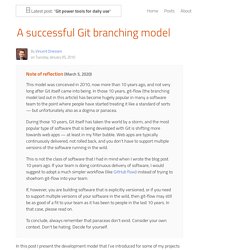

Why I Like Mercurial More Than Git. After working for over a year alternating between two projects, one that uses Git for its version control and another that uses Mercurial, I have finally achieved sufficient mastery of both toolchains that I now feel comfortable defending my judgment that Mercurial is the superior of the two systems.

I think Git has one glaring deficiency that makes it the inferior tool, and I hope to describe the required remedy in this weblog posting. The tools are very similar, and many of the distinguishing differences come down to a matter of taste in my opinion. Some may consider it a deal-breaker that Mercurial expects its extensions to be written in Python, whereas Git admits extensions written in just about any language you care to imagine, but the usual approach is to write them in a shell language. That's not a deal-breaker for me. Many other differences are either consequences of that fundamental distinction, or they are cosmetic in nature. Understanding the Git Workflow. If you don’t understand the motivation behind Git’s design, you’re in for a world of hurt.

With enough flags you can force Git to act the way you think it should instead of the way it wants to. But that’s like using a screwdriver like a hammer; it gets the job done, but it’s done poorly, takes longer, and damages the screwdriver. Consider how a common Git workflow falls apart. Create a branch off Master Work Merge it back to Master when done Most of the time this behaves as you expect because Master changed since you branched. Unfortunately, your feature branch contained checkpoint commits, frequent commits that back up your work but captures the code in an unstable state. So you add a new rule: “When you merge in your feature branch, use –no-ff to force a new commit.” Then one day you discover a critical bug in production, and you need to track down when it was introduced.
You narrow the bug to a single file. DVCSAnalysis - support - Analysis of Git and Mercurial - User support for Google Project Hosting. A successful Git branching model » nvie.com. Note of reflection (March 5, 2020)This model was conceived in 2010, now more than 10 years ago, and not very long after Git itself came into being.

In those 10 years, git-flow (the branching model laid out in this article) has become hugely popular in many a software team to the point where people have started treating it like a standard of sorts — but unfortunately also as a dogma or panacea.During those 10 years, Git itself has taken the world by a storm, and the most popular type of software that is being developed with Git is shifting more towards web apps — at least in my filter bubble.
Web apps are typically continuously delivered, not rolled back, and you don't have to support multiple versions of the software running in the wild.This is not the class of software that I had in mind when I wrote the blog post 10 years ago. Why git? ¶ For a thorough discussion on the pros and cons of Git compared to centralized source code control systems, see the web. The main branches ¶